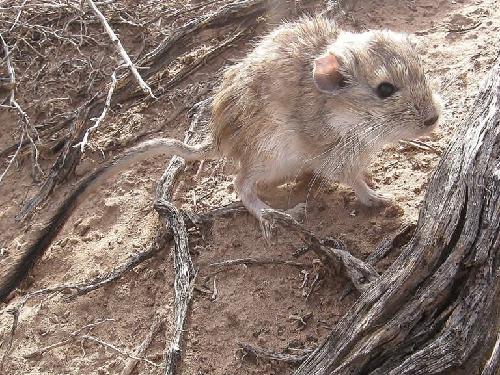Social media video feaaturing the project.
Ecología espacial rata vizcacha colorada/ Spatial ecology of the red vizcacha rat.
23 Jul 2018 Lagunas del Rosario de Huanacache, Argentina, Central and Latin America Mammals
The red viscacha rat is an endemic small mammal to aridlands of the Monte desert, central-western Argentina. Their populations occur at low densities, distributed in isolated patches. Previous studies have shown different levels of genetic differentiation along its distribution; however, basic factors related to the spatial ecology, habitat use and dispersal of the red viscacha rat are unknown. The aim of this project is to quantify and characterize the spatial ecology of the red viscacha rat in the heterogeneous landscapes at multiple scales of the Monte desert, in order to devise further guidelines for their conservation.

Rata vizcacha colorada.
Habitat fragmentation, caused by geological processes or human activity could create small, isolated patches, disrupting and causing local extinctions. Facing with this fact, is necessary inferring which factors affect small mammals dynamics and their ecosystem. The Red Viscacha Rat (RVR) is an octodontid rodent, endemic to the arid lands of central western Argentina.
Several ecological and biogeographic traits such as, narrow geographic range, patchy distribution, habitat specialization (associated to “salars” or salt flats) and low population density increase its vulnerability. In previous studies, genetic distinctiveness has been detected along the distribution of the RVR, suggesting important implications on the management of these populations. Despite this, there are questions that remained unanswered: How often do individuals change their burrows? How are their daily movements? What is the spatial arrangement and average distance among burrowing systems at different scales? However, the understanding of these questions is necessary for further conservation guidelines of the RVR. The contribution of the research will be:
a) to obtain and quantify fundamental information about the role played by habitat heterogeneity on the spatial ecology, population structure and dispersal dynamics of desert specialist rodents
b) to provide stronger ecological basis for the development of guidelines oriented towards the management of isolated populations.
After obtaining first data, a high resolution map for detecting landscape units and suitable areas for the RVR will be designed. This map will be powerful tool for detecting core areas with priority management. Moreover, these bases will serve as guidelines to promote conservation plan. The monitoring of local trends (home range) and long distance interactions (dispersal) representing part of necessary toolkit for in-situ management of potential populations with higher genetic distinctiveness.
Social media video feaaturing the project.
Ecología espacial rata vizcacha colorada/ Spatial ecology of the red vizcacha rat.